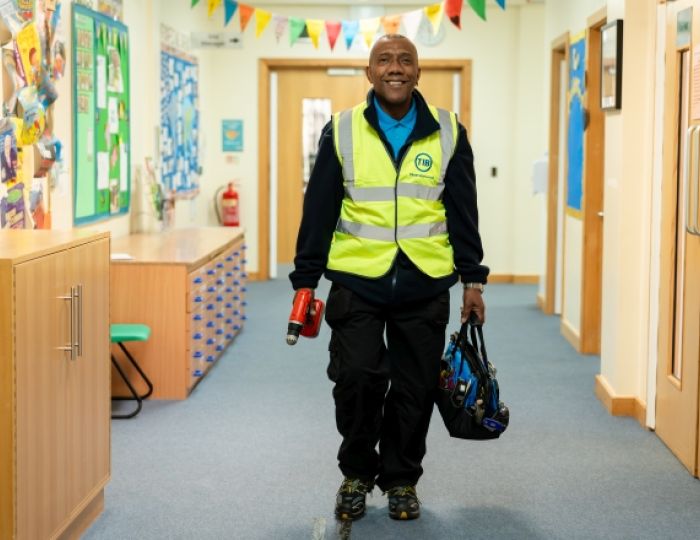As well as benefiting the environment, making energy efficiency improvements to your school has the added advantage of bringing significant financial savings. This enables you to redirect funds to other important areas.
Replace old technologies
Replacing outdated technologies with more efficient upgrades is a good place to start when it comes to tackling your energy efficiency.
It’s likely to be the first port of call for any energy manager if your school’s energy bills and maintenance costs are notably high.
Finding out what your school’s energy spend per pupil is will give a good indication of what you could be aiming for. To do this, divide your annual energy bill by the number of pupils.
With lighting accounting for a significant proportion of electricity expended within education, upgrading inefficient lighting to more modern LED alternatives is a great starting point for schools wanting to implement energy-saving measures. It’s one of the most effective ways to increase your energy efficiency.
Identify inefficient use of energy
Installing lighting controls and adding motion sensors further reduces energy usage. The longer lifespan of LED lamps also decreases maintenance costs.
As well as these benefits, new LEDs can also improve the aesthetics of buildings and enhance learning and teaching environments.
It is important to identify where you can conserve energy. Walk around school and liaise with your site manager, who will be aware of any day-to-day issues.
This can help to establish areas for improvement, such as windows remaining open when radiators are in use, or lights being left on when they are not needed. This is a problem which can be easily addressed with lighting sensors.
Energy consumption can also be reduced by updating energy control systems. New smart technologies allow for more precise control, especially if combined with an energy management system.
This gives you the ability to quickly, easily and often automatically adjust your energy systems to meet your needs in real-time.
Get pupils involved
Involving pupils in any energy efficiency projects you are working on helps to educate them on important environmental issues. It can also inspire them to play an active role in reducing energy use themselves.
Offer fun interactive workshops and presentations on climate change to enable pupils to learn about energy-saving measures. Set up eco-clubs to boost energy awareness and encourage discussions and learning around the subject.
In particular, I’ve found that involving pupils in competitions, such as mini switch-off walk-arounds, and rewarding them for their energy-saving efforts, is particularly effective.
Allow pupils to present evidence of the savings they have achieved for their school – either as individuals or groups – during assemblies. This will keep them engaged in energy-saving efforts and make them feel proud of the role they have played.
As part of one of my projects with Torfaen County Borough Council, we held a ‘switch off fortnight’ campaign. This involved urging students to go around switching appliances off to save energy.
Changes in usage were monitored through meter readings. Pupils received bronze, silver, gold or platinum Eco Award certificates from staff. They loved showing how they made a difference.
Choose the right technologies to invest in
Aside from replacing outdated lighting, investing in additional energy-efficient technologies should be at the forefront of any plans.
Simple measures like adding insulation or heating controls can achieve substantial energy and financial savings. Schools can save thousands of pounds a year through such investments.
Installing building energy management systems (BEMS) can be very effective. They act as a central point of control for multiple building services.
Used to control heating, ventilation and air conditioning all in one, BEMS provide a way to monitor and rapidly adjust equipment. This improves the reliability and performance of buildings and delivers considerable savings.
Renewables such as solar panels and heat pumps can also be viable options to help future-proof buildings.
As the cost of Solar PV has fallen, it’s a beneficial measure for schools looking to lower their carbon footprint and reduce their dependence on grid electricity.
Solar PV installations are also a popular way to raise awareness of the sustainability agenda amongst students and the local community.
Make the most of funding
The case for investing in energy efficiency can seem obvious. However, for many schools, concerns over how to finance such investments may be a barrier.
However, funding options are available to help invest in such technologies, from companies such as Salix Finance.
Take a holistic approach
Choosing to address energy efficiency holistically is the most effective way of maximising energy, carbon and cost savings.
This involves implementing multiple projects at the same time rather than investing in just one type of technology.
Many schools begin addressing their energy usage by installing LED lighting. However, a school taking a holistic approach might want to consider whether they could also install the following within the same project:
- lighting sensors
- energy management systems
- new insulation
- low-carbon heating
- solar PV
As well as boosting annual savings, such an approach also helps save money on design, installation and labour costs. It also minimises disruption on site.
Case study: Torfaen County Borough Council
Ceri has played a leading role in helping Torfaen County Borough Council improve its schools’ energy efficiency.
It has installed a range of new measures, including LED lighting, automatic lighting controls, BEMS projects and eight boiler replacements.
These projects have significantly reduced carbon emissions and energy bills, collectively lowering emissions by around 672 tonnes a year. Annual savings have been over £151,000.
In total, they are expected to save over £2.6m over the lifetime of the technologies. This will help ease financial strains currently faced by the schools.
Going forward, Ceri plans to install further energy efficiency measures across schools in the borough. This includes more LED and BEMS projects, as well as controls on boilers.
The council is also exploring Solar PV, combined with battery storage and heat pumps. These have the potential to provide substantial savings and address heat decarbonisation.
Ceri Williams is Schools Energy and Finance Officer at Torfaen County Borough Council. She has over 20 years of experience in the sector.










